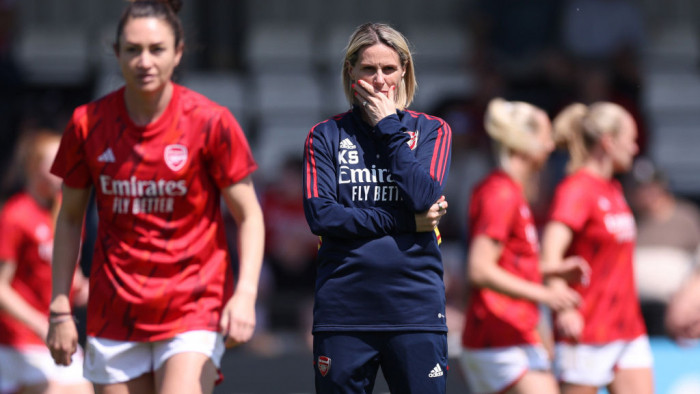English football’s promoted clubs have set a new record – but what does it mean?
Is this season a one-off, or is there a pattern


When the final whistle blew at Stamford Bridge on Wednesday, Huddersfield Town’s players reacted with a blend of euphoria and relief.
Their 1-1 draw ensured they will be playing Premier League football again next year, just as it looked as though they might drop out of the league at the last.
With Newcastle United and Brighton & Hove Albion confirming their survival a game or two earlier, it marked only the third time all three promoted sides have stayed up in the Premier League era.
However, it’s not just the top division where the league’s newest additions have lasted the course. Not a single team from any of the top four divisions in the English football pyramid has gone straight back down this year.
In the Championship, Bolton Wanderers clawed their way out of danger on the final day but fellow new-boys Sheffield United and Millwall looked more likely to make the play-offs than to drop down.
Doncaster Rovers were the lowest-placed of the four teams promoted to League One in 2017, finishing 15th, while Portsmouth, Plymouth Argyle and Blackpool all recorded top-half finishes.
And in League Two, Forest Green Rovers bounced back from winning just one of their first 13 games to stay afloat, while Lincoln City have a shot at a second straight promotion via the play-offs.
The Premier League trio might still be the most impressive, however, simply by virtue of the relative ease with which they have kept their heads above water: Brighton, Huddersfield and Newcastle have spent a combined four weeks in the bottom three all season, and two of the three are still in contention for a top-half finish with one game to go.
So, how much can we read into the achievements? Are they a one-off, or are they a sign that things are changing between the haves and have-nots?

Bolton left it late to stay up - but they did it
When the most recent top-flight TV deal came into force, there was a major concern that it would only serve to widen the gulf between the Premier League and those in the divisions below.
Promoted teams might stay up, people thought, but only with the kind of bold investment that has seen other clubs struggle when their luck runs out - Sunderland and QPR have struggled in the second tier after splurging huge sums in vain attempts to avoid relegation from the Premier League; the former dropping straight down to League one after a truly cataclysmic season and the latter yet to register a positive goal difference or a finish higher than 12th in their three years back in the Championship.
This season’s promoted clubs have been far more cautious, perhaps with those clubs’ struggles in the back of their mind should they be instantly relegated - and it’s worked. Newcastle spent just £44.9m across the summer and winter transfer windows, though none of their new arrivals has started more than 21 times in the league this season. Huddersfield’s outlay has been similar, though Laurent Depoitre – scorer of the goal that kept them up, cost just £3.5m. Meanwhile Brighton were at around the same mark until January, when they broke their transfer record for Jürgen Locadia, though the Dutch forward has started just two games.
The other thing that clubs supposedly needed to stick around in the top flight was experienced Premier League players, yet Newcastle, with Jonjo Shelvey key to their survival this year, are the only one of the top-flight trio to whom this applies. Brighton’s first choice goalkeeper and back four had a combined five Premier League games to their name before this season, while Glenn Murray is the only player with more than one Premier League start for the club who had scored in the division before 2017.
It’s a similar story with Huddersfield – of those to feature in more than half of the Terriers’ league games this season, only Jonathan Hogg (five games for Aston Villa) and Tom Ince (15 for Crystal Palace and Hull City) had stepped on a Premier League pitch before the campaign began.

Shelvey is one of the survivors from Newcastle’s last Premier League campaign
Another striking difference is seen in managerial changes: nine of the Premier League’s bottom 13 clubs have changed managers during the course of the campaign, with West Brom doing so twice, but the promoted three are among the quartet to stick with the same man throughout the campaign.
This may partly stem from not being as worried about relegation and its impacts as some other clubs – their recent experience gives them confidence that it won’t be too bad, while for more established teams it’s more of an unknown – but it has helped provide some continuity.
Rafa Benítez, Chris Hughton and David Wagner all had to adapt and adjust in the 46-game Championship season in order to take their teams up, and each of the three has been able to react to poor runs of form to turn things around one division higher.
There’s an argument that all three staying afloat in such a scenario is no coincidence: the first time the three promoted clubs stayed up, in the 2001/02 season, Blackburn Rovers, Bolton Wanderers and Fulham all stuck with the men who brought them up, while two of the relegated clubs – Derby County and Leicester City – opted to twist.
Similarly, in 2011/12, Norwich City put their faith in Paul Lambert and Swansea City did the same with Brendan Rodgers, both securing comfortable mid-table finishes, while QPR – the only promoted club to make a managerial switch – were the closest of the three to relegation.

Rodgers kept Swansea out of danger after winning the Championship play-off final
The gulf between the top and bottom of the league has been reflected in the results between ‘Big Six’ clubs (Manchester City, Manchester United, Liverpool, Tottenham Hotspur, Chelsea and Arsenal) and those lower down the table, and this might also explain the success of the newly-promoted clubs.
This season’s top four have only lost six times to clubs finishing seventh or lower – that’s just over 5% of the games in question – and three of those six came against promoted clubs.
Could it be that a lack of fear, or indeed the rush of a first game against a big club after spending a long season without such opposition, carried them to this?
There’s no reason why a more established club should have any more apprehension, save for a once bitten, twice shy approach after a heavy defeat, but none of Brighton, Huddersfield and Newcastle’s wins over Manchester United could be considered smash-and-grabs.

Brighton hit 40 points with a win over Manchester United
Next season will be very interesting, considering the make-up of the clubs coming up from the Championship and those dropping out of the Premier League.
Wolves have spent heavily, and are likely to continue spending, having forked out £15.8m for Ruben Neves at the start of their promotion campaign, but Cardiff may be more careful with their outlay.
As for the play-off prospects, Aston Villa, Derby County, Fulham and Middlesbrough have all been unafraid to spend in the Championship, while each of the quartet parted ways with managers en route to their most recent Premier League relegations, so they’ll need to hold their nerve better this time around.
The 2018/19 campaign should provide a good guide to whether the gap between the bottom of the Premier League and the top of the Championship has truly narrowed, or whether we’ve just been enjoying an anomaly of three clubs with sensible managers, and less fear than the rest of the division, making the most of their limited resources.
We’ve long heard about ‘second season syndrome’, where promoted clubs have a hot year before falling away, so now’s the time for them to prove they’re here for the long haul.
(Images: Getty)
Latest
Related Reviews and Shortlists









